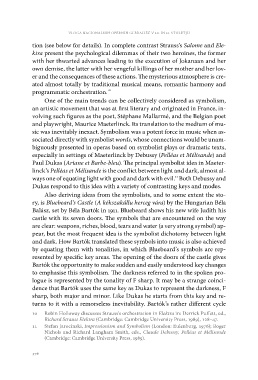Page 378 - Weiss, Jernej, ur. 2019. Vloga nacionalnih opernih gledališč v 20. in 21. stoletju - The Role of National Opera Houses in the 20th and 21st Centuries. Koper/Ljubljana: Založba Univerze na Primorskem in Festival Ljubljana. Studia musicologica Labacensia, 3
P. 378
vloga nacionalnih opernih gledališč v 20. in 21. stoletju
tion (see below for details). In complete contrast Strauss’s Salome and Ele-
ktra present the psychological dilemmas of their two heroines, the former
with her thwarted advances leading to the execution of Jokanaan and her
own demise, the latter with her vengeful killings of her mother and her lov-
er and the consequences of these actions. The mysterious atmosphere is cre-
ated almost totally by traditional musical means, romantic harmony and
programmatic orchestration.10
One of the main trends can be collectively considered as symbolism,
an artistic movement that was at first literary and originated in France, in-
volving such figures as the poet, Stéphane Mallarmé, and the Belgian poet
and playwright, Maurice Maeterlinck. Its translation to the medium of mu-
sic was inevitably inexact. Symbolism was a potent force in music when as-
sociated directly with symbolist words, whose connections would be unam-
biguously presented in operas based on symbolist plays or dramatic texts,
especially in settings of Maeterlinck by Debussy (Pelléas et Mélisande) and
Paul Dukas (Ariane et Barbe-bleu). The principal symbolist idea in Maeter-
linck’s Pelléas et Mélisande is the conflict between light and dark, almost al-
ways one of equating light with good and dark with evil.11 Both Debussy and
Dukas respond to this idea with a variety of contrasting keys and modes.
Also deriving ideas from the symbolists, and to some extent the sto-
ry, is Bluebeard’s Castle (A kékszakállu herceg vára) by the Hungarian Béla
Balász, set by Béla Bartók in 1911. Bluebeard shows his new wife Judith his
castle with its seven doors. The symbols that are encountered on the way
are clear: weapons, riches, blood, tears and water (a very strong symbol) ap-
pear, but the most frequent idea is the symbolist dichotomy between light
and dark. How Bartók translated these symbols into music is also achieved
by equating them with tonalities, in which Bluebeard’s symbols are rep-
resented by specific key areas. The opening of the doors of the castle gives
Bartók the opportunity to make sudden and easily understood key changes
to emphasise this symbolism. The darkness referred to in the spoken pro-
logue is represented by the tonality of F sharp. It may be a strange coinci-
dence that Bartók uses the same key as Dukas to represent the darkness, F
sharp, both major and minor. Like Dukas he starts from this key and re-
turns to it with a remorseless inevitability. Bartók’s rather different cycle
10 Robin Holloway discusses Strauss’s orchestration in Elektra in: Derrick Puffett, ed.,
Richard Strauss Elektra (Cambridge: Cambridge University Press, 1989), 128–47.
11 Stefan Jarocinski, Impressionism and Symbolism (London: Eulenburg, 1976); Roger
Nichols and Richard Langham Smith, eds., Claude Debussy, Pelléas et Mélisande
(Cambridge: Cambridge University Press, 1989).
376
tion (see below for details). In complete contrast Strauss’s Salome and Ele-
ktra present the psychological dilemmas of their two heroines, the former
with her thwarted advances leading to the execution of Jokanaan and her
own demise, the latter with her vengeful killings of her mother and her lov-
er and the consequences of these actions. The mysterious atmosphere is cre-
ated almost totally by traditional musical means, romantic harmony and
programmatic orchestration.10
One of the main trends can be collectively considered as symbolism,
an artistic movement that was at first literary and originated in France, in-
volving such figures as the poet, Stéphane Mallarmé, and the Belgian poet
and playwright, Maurice Maeterlinck. Its translation to the medium of mu-
sic was inevitably inexact. Symbolism was a potent force in music when as-
sociated directly with symbolist words, whose connections would be unam-
biguously presented in operas based on symbolist plays or dramatic texts,
especially in settings of Maeterlinck by Debussy (Pelléas et Mélisande) and
Paul Dukas (Ariane et Barbe-bleu). The principal symbolist idea in Maeter-
linck’s Pelléas et Mélisande is the conflict between light and dark, almost al-
ways one of equating light with good and dark with evil.11 Both Debussy and
Dukas respond to this idea with a variety of contrasting keys and modes.
Also deriving ideas from the symbolists, and to some extent the sto-
ry, is Bluebeard’s Castle (A kékszakállu herceg vára) by the Hungarian Béla
Balász, set by Béla Bartók in 1911. Bluebeard shows his new wife Judith his
castle with its seven doors. The symbols that are encountered on the way
are clear: weapons, riches, blood, tears and water (a very strong symbol) ap-
pear, but the most frequent idea is the symbolist dichotomy between light
and dark. How Bartók translated these symbols into music is also achieved
by equating them with tonalities, in which Bluebeard’s symbols are rep-
resented by specific key areas. The opening of the doors of the castle gives
Bartók the opportunity to make sudden and easily understood key changes
to emphasise this symbolism. The darkness referred to in the spoken pro-
logue is represented by the tonality of F sharp. It may be a strange coinci-
dence that Bartók uses the same key as Dukas to represent the darkness, F
sharp, both major and minor. Like Dukas he starts from this key and re-
turns to it with a remorseless inevitability. Bartók’s rather different cycle
10 Robin Holloway discusses Strauss’s orchestration in Elektra in: Derrick Puffett, ed.,
Richard Strauss Elektra (Cambridge: Cambridge University Press, 1989), 128–47.
11 Stefan Jarocinski, Impressionism and Symbolism (London: Eulenburg, 1976); Roger
Nichols and Richard Langham Smith, eds., Claude Debussy, Pelléas et Mélisande
(Cambridge: Cambridge University Press, 1989).
376


